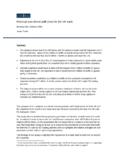Transcription of Unlocking the potential of disclosure committees - EY
1 Unlocking the potential of disclosure committeesLeading practices and trends Contents Introduction 1 Executive summary 3 Survey results and interviews 7 Characteristics of respondents 8 Organization of the disclosure committee 13 Function of the disclosure committee 20 Interactions with external auditors, other external advisors and the audit committee 23 Effectiveness and streamlining 24 Challenges, strengths and weaknesses, efficiency, complexity 25 Emerging SEC data trends 28 Appendix A: Jump-starting a disclosure committee an eight-step road map to success 30 Appendix B: Sample disclosure committee charter 31 Appendix C: A self-assessment checklist 33 Appendix D: Excerpts from Sections 302 and 906 of the Sarbanes-Oxley Act 34 Copyright 2014 by Financial Executives Research Foundation, Inc.
2 And Ernst & Young LLP. All rights reserved. No part of this publication may be reproduced in any form or by any means without written permission from the rules and Securities and Exchange Commission (SEC) regulations governing corporate reporting keep changing, with predictable results: as the goal posts continue to shift, disclosure burdens mount. New regulations and accounting standards enacted in the wake of high-profile financial failures meaningfully expanded the scope of corporate disclosures and accountability, while also stepping up investor and government scrutiny. At the same time, companies keep moving into new markets around the world, increasing the volume and complexity of reporting requirements. These burdens fall heaviest on the chief executive officer (CEO) and chief financial officer (CFO), who must certify the validity and completeness of disclosures under Sections 302 and 906 of the Sarbanes-Oxley Act of 2002 (SOX).
3 But do they have all of the information they need to fulfill that mandate? With so much in flux, and so much at stake, it is imperative that companies take a fresh look at their reporting processes to make sure that their disclosures are appropriate and robust, that they meet regulatory and investor expectations and that their CEO and CFO are being fully supported. As part of that reexamination, companies should explore the role that disclosure committees can play to underpin and help ease disclosure burdens on their audit committees and finance functions, and improve their disclosure that goal in mind, the Financial Executives Research Foundation (FERF) in conjunction with EY has prepared this report about disclosure committees , to examine why companies have them, how they are positioned in the overall organization and in what ways they are used to drive efficiency, effectiveness and accountability.
4 The project began earlier this year when we sent a web-based survey to senior financial executives who are members of Financial Executives International (FEI) and to clients of EY. The survey consisted of more than two dozen questions about disclosure committees . We received more than 100 responses from companies in a wide variety of industries. Eighty-one percent of the respondents are publicly traded companies, and more than half have revenue exceeding $2 billion a complement those results, we conducted in-depth interviews with more than a dozen experts who have extensive experience in this area as committee members, non-member participants, audit committee members and external counsel. Although disclosure committees are not required under SOX, the watershed Act that imposed tough new mandates for controls and disclosures a dozen years ago, many companies have formally chartered them in the wake of SOX s passage so many that it can be said that the committees are becoming a customary feature of corporate governance.
5 The reason for their popularity was reflected again and again in our survey results and one-on-one interviews. Companies see great value in centralizing their thinking about disclosures , helping the organization s finance function, other senior management and audit committee to anticipate and assess the full range of disclosure issues they face whether small or large, regularly scheduled or borne of crisis and to act in a coordinated manner. For their part, CEOs and CFOs gain comfort from the work that their committees perform. Introduction1 Unlocking the potential of disclosure committees Leading practices and trends |All of this assumes, however, that the committees are thoughtfully constituted and then managed in a conscientious and consistent way that taps their full report reveals a picture of leading practices that is still coming into focus, with consensus in some areas and differences in others as companies feel their way in structuring and operating their committees .
6 That said, the broad range of experiences and findings presented here a roster of successes but also of midcourse corrections should prove helpful to senior executives who already have such committees and are looking to maintain or improve their value, and to those who are still thinking about forming one. And because companies have on occasion failed to disclose pertinent information and triggered the receipt of an SEC comment letter forcing a restatement of a financial filing or sometimes causing hefty penalties to be imposed on the company and senior executives it behooves all members of a disclosure committee to use the committee to its full potential . In furtherance of this goal, we hope you find our report BukspanPartner, Ernst & Young LLPEY Americas disclosure LeaderFinancial Accounting Advisory Services+1 212 773 Matt PostaPartner, Ernst & Young LLPEY Americas Accounting Policy and Governance LeaderFinancial Accounting Advisory Services+1 212 773 Leena RoselliSenior Manager, ResearchFinancial Executives Research Foundation, Inc.
7 +1 973 765 Unlocking the potential of disclosure committees Leading practices and trends Executive summaryMost companies consider disclosure committees to be an important tool for effectively promoting compliance with the 2002 SEC rules for disclosure controls and procedures, as well as the certification of annual and quarterly reports. These rules ( , Rules 13a-14 & 15 and 15d-14 & 15) were adopted by the SEC in 2002 following passage of the Sarbanes-Oxley Act, sweeping legislation that refocused companies on the importance of internal control. The rules require that SEC registrants establish, maintain and evaluate the effectiveness of their disclosure controls and procedures. They also require the CEO and the CFO to certify the company s financial and other information contained in annual and quarterly reports. The officers are required to certify1 that they are responsible for establishing, maintaining and regularly evaluating the effectiveness of their company s internal controls.
8 Separately, under Section 404 of SOX, management must assess and report on the effectiveness of their company s internal controls over financial reporting, or ICFR, a review commonly made in accordance with the COSO framework. Although a disclosure committee is not itself a requirement under either SOX or the 2002 rules, establishing one was recommended by the SEC. (See sidebar.) A well-managed disclosure committee can help senior financial executives discharge their complicated and time-consuming responsibilities while also serving as an integral part of risk mitigation. Despite that, precisely how such committees are established and operated is still very much a work in progress even 12 years after SOX was fact, many companies are coming up short on implementation, according to one of the experts we interviewed, Brinkley Dickerson, a leading securities and transactional attorney who is a partner in Atlanta at Troutman Sanders.
9 Over the course of many seminars, I informally surveyed thousands of attendees representing a meaningful slice of the public company population, Mr. Dickerson said. I start by asking, Do you have a disclosure committee? A substantial majority of the attendees will raise a hand. Then I ask, OK, how many of your disclosure committees meet consistently, have an issues-focused agenda ( , are not a substitute for just a drafting session), get input from the top management team on issues within their knowledge, and track their work so that they can develop some sort of knowledge base over time? Only a few hands are left up. Sometimes, very few. And that s the critical dividing line, he said. Where a disclosure committee includes the right people and goes through the right process, it is a positive process. Where it does not, it is not. In fact, at that point, its mere existence is a potential liability as people within the corporate organization are relying on it for activities that it is not performing.
10 Specifically, it is quite important for the disclosure committee to interact with the audit committee, many of the experts said. And yet, 43% of our survey respondents who have disclosure committees conceded that there was no formal interaction. 1 Under Sections 302 and 906 see Appendix the potential of disclosure committees Leading practices and trends | I have found myself disappointed about the lack of audit committee participation, a New York-based external counsel, another of the experts we interviewed, said of his experience in general. Anything you can do to increase the engagement of the audit committee, and the board of directors, is good. To learn more, we sought to obtain answers to the foundational questions that we posed in our survey, such as: What is the committee s role? Who are the official members? How often should they meet?

















